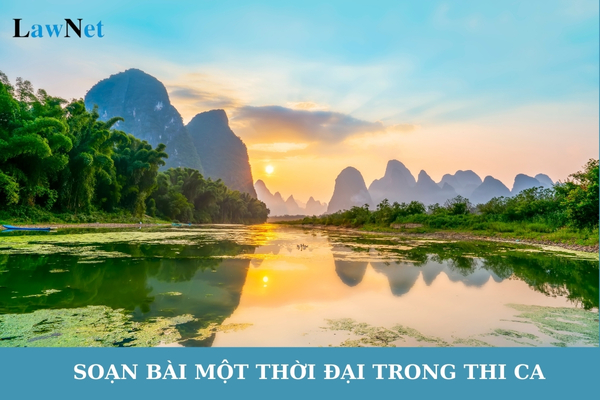What are the guidelines for preparing the shortest lesson "Một thời đại trong thi ca"? What are the criteria for selecting text corpus used in the Literature curricula in Vietnam?
What are the guidelines for preparing the shortest lesson "Một thời đại trong thi ca"?
"Một thời đại trong thi ca" by Hoai Thanh is a work included in the 11th-grade Literature curriculum.
Students may refer to the following sample lesson "Một thời đại trong thi ca":
|
Sample lesson "Một thời đại trong thi ca"
|
Note*: The information is for illustration purposes only*

What are the guidelines for preparing the shortest lesson "Một thời đại trong thi ca"? What are the criteria for selecting text corpus used in the Literature curricula in Vietnam? (Image from the Internet)
What are the criteria for selecting the text corpus used in the Literature curricula in Vietnam?
Under Section V of the General Education Program for Literature issued along with Circular 32/2018/TT-BGDDT, the criteria for selecting the text corpus used in the Literature curricula are as follows:
- In the Literature subject, text corpus forms a component of the educational content, contributing significantly to shaping and developing in students the qualities and competencies outlined in the program. The program only provides direction on the types of texts and genres taught at each level; particularly at the primary level, it specifies the length of the texts.
- To meet the requirements of shaping and developing qualities and competencies for students, the text corpus is selected ensuring the following criteria:
+ Directly serve the development of qualities and competencies according to the goals and required achievements of the program.
+ Appropriate to the experiences, cognitive abilities, and psychological characteristics of students at each grade level. Words used as text corpus to teach language at the primary level are selected within the scope of cultural vocabulary, have positive meanings, ensure the goals of education on qualities, language, and aesthetics, and are suitable for students' psychology.
+ Possesses special value in content and artistry, is typical of text types and genres, standard and creative in language.
- Reflects achievements in ideology, literature, and national culture; embodies the spirit of patriotism, national independence, and national sovereignty awareness; has the humanity, educates compassion, tolerance, love for truth, beauty, love for nature, international integration spirit, and aims toward the universal values of humanity.
The program has an open orientation regarding text corpus. However, to ensure core educational content is unified nationwide, accompanying suggested texts for textbook authors and teachers to choose from, the program stipulates some mandatory texts and mandatory selected texts.
What are the objectives of the Literature curricula at the upper secondary level in Vietnam?
Under Section III of the General Education Program for Literature issued along with Circular 32/2018/TT-BGDDT, the objectives of the Literature curricula at the upper secondary level are as follows:
- Help students continue to develop the qualities that have been formed in the lower secondary level; expand and enhance the requirements for developing qualities with specific manifestations: being assertive, having personality, having ideals and ambitions, knowing how to preserve and promote Vietnamese cultural values; having a spirit of integration and a sense of global citizenship.
- Continue to develop the competencies formed in the lower secondary level with higher required achievements: understanding both explicit and implicit content of various text types at a higher difficulty level demonstrated through volume, content, and reading comprehension requirements; reading with the requirement to develop critical thinking.
- Apply knowledge of literary features, literary trends, author styles, works, internal and external textual factors to form independent reading abilities. Master the essay and comprehensive exposition writing style (combining expressions and argumentative techniques), following procedure, having a stance, ensuring logic and persuasiveness. Speak and listen flexibly; have the ability to listen and evaluate the content and form of a presentation; know how to participate and have a stance, personality, and appropriate debating attitude.
- Develop literary competence with requirements: distinguish literary works from other types of artistic works; analyze and comment on the characteristics of literary language; distinguish the expression and the expressed in literature; recognize and analyze, appreciate literary works based on literary style characteristics; have a rich imagination, know how to enjoy, receive, and evaluate literature; create some products with literary qualities.

